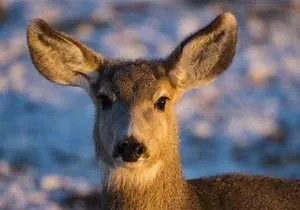Mating season and the quest for more secure habitat have deer on the move this time of year, increasing the chances of vehicle collisions. Typically, the greatest occurrence of deer-vehicle crashes is in mid-November when the rut, or mating season, peaks.
“In addition to the rut, deer are also on the move in mid-fall seeking new locations as crops are harvested and leaves fall from trees and shrubs, leaving them less secure than in their summer habitats,” said Kansas Department of Wildlife, Parks and Tourism biologist Lloyd Fox.
According to the Kansas Department of Transportation, 15 percent of Kansas crashes last year were deer-related (crashes in which a deer and vehicle actually collided or the presence of a deer was a contributing circumstance). Although crashes involving deer occur throughout the year in every Kansas county, the highest number of crashes typically occur where there are the most vehicles. Sedgwick County had 422 deer-vehicle crashes in 2014, the most of any county.
The Kansas Highway Patrol (KHP) cautions drivers to avoid taking extra-ordinary measures to avoid striking a deer in the road, lest a bad situation become even worse.
“If you are unfortunate enough to have a deer enter the highway in front of your car, it is best to hit the animal and not swerve to avoid it,” said the KHP’s Lt. Adam Winters. “Often we find more serious crashes occur when you swerve in avoidance.”
Other tips to avoid deer collisions include:
- Be especially watchful at dawn and dusk when deer are particularly active.
- Watch for more than one deer, as they seldom travel alone.
- Reduce speed and be alert near wooded areas or green spaces such as parks or golf courses and near water sources such as streams or ponds.
- Deer crossing signs show where high levels of deer/vehicle crashes have occurred in the past.
- Use your bright lights to help you detect deer as far ahead as possible.
- Always wear a seat belt and use appropriate child safety seats. Even if you are waiting in your car, it is best to wear your seat belt, and have your children in car seats.
If you do hit a deer, here are some additional tips:
- Don’t worry about the animal. Law enforcement will arrange to have the animal removed from the road when they arrive. Tell law enforcement dispatch if the deer is still in the road when reporting the crash call.
- If possible, remain in the vehicle, and remain buckled up, protecting yourself in the event there is a secondary crash involving another vehicle.
- If you must be outside your vehicle, stand as far off the road as possible; make sure hazard lights are activated; don’t stand between your vehicle and another vehicle; and make sure children are kept properly restrained in your vehicle.
- If you hit a deer, slow down, pull onto the shoulder and turn on the emergency flashers.
To report a crash on Kansas highways from a cellular phone, call *47 (*HP) for a highway patrol dispatcher or *582 (*KTA) for assistance on the Kansas Turnpike. The crash can also be reported by dialing 911.
Photo credit: David Beyer




